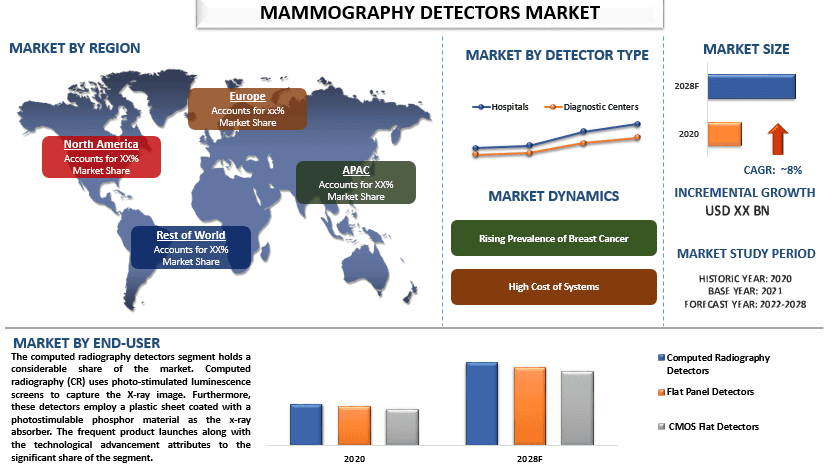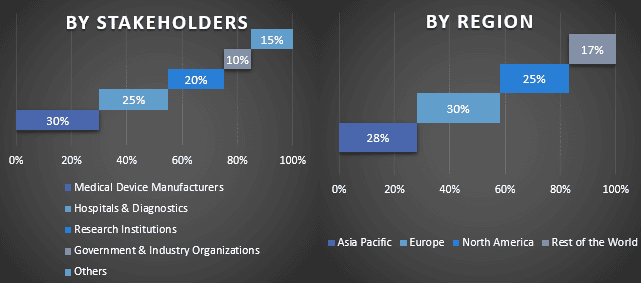- Home
- About Us
- Industry
- Services
- Reading
- Contact Us
Mammography Detectors Market: Current Analysis and Forecast (2022-2028)
Emphasis on Detector Type (Computed Radiography Detectors, Flat Panel Detectors, and CMOS Flat Detectors); End-User (Hospitals and Diagnostic Centers); Region (North America, Europe, Asia-Pacific, Rest of the World); and Region/Country

The global mammography detectors market is expected to grow at a significant rate of around 8% during the forecast period. Mammography is a specific type of breast imaging that uses low-dose x-rays to detect cancer early stage. The rise in breast cancer incidence, increased public awareness of the disease’s early detection, rising demand for advanced diagnostic tools, and technological developments in mammography detectors are important factors contributing to the growth of the mammography detectors market. For instance, in November 2022, the Radiological Society of North America (RSNA) launched the RSNA Screening Mammography Breast Cancer Detection AI Challenge.
Analogic Corporation, General Electric Company, Hologic Inc., Koninklijke Philips N.V., Gamma Medical Inc.., Siemens Healthcare GmbH, SonoCiné, Toshiba Corporation, Teledyne DALSA, and Varex Imaging are some of the key players in the market. Several M&As along with partnerships have been undertaken by these players to facilitate customers with hi-tech and innovative products/technologies.
Insights Presented in the Report
“Amongst Detector Type, CMOS flat detectors category to witness higher CAGR during the forecast period”
Based on the detector type, the market has been categorized into computed radiography detectors, flat panel detectors, and CMOS flat detectors. Among them, the CMOS flat detectors segment is expected to grow at a considerable rate in the market. CMOS sensor design to provide a new level of performance and reliability for X-ray systems used in mammography. CMOS Detectors are flexible, stable, sensitive, and faster while producing higher-resolution images. The rising demand for technologically advanced equipment and the flexibility & stability provided by CMOS flat detectors are the driving factors for the segmental area during the forecast period.
“Amongst End-User, diagnostic centers segment to hold a higher CAGR during the forecast period”
Based on the end-user, the market has been categorized into hospitals and diagnostic centers. Among them, the diagnostic centers segment is expected to grow at a significant CAGR during the forecast period. Diagnostic centers have been beneficial in situations involving chronic diseases since they are important for disease prevention, identification, and management by influencing the proper clinical decision-making.
“Asia Pacific to witness the fastest growth in the market”
Asia-Pacific is anticipated to grow at the fastest rate during the forecast period. The major factors such as increasing cases of breast cancer and rising research in the medical industry in the region are the important reasons for the growth of the market in the region. For instance, breast cancer is the most common cancer affecting women, and in Japan, it affects more than 90,000 people each year.
Reasons to buy this report:
- The study includes market sizing and forecasting analysis validated by authenticated key industry experts.
- The report presents a quick review of overall industry performance at one glance.
- The report covers an in-depth analysis of prominent industry peers with a primary focus on key business financials, product portfolio, expansion strategies, and recent developments.
- Detailed examination of drivers, restraints, key trends, and opportunities prevailing in the industry.
- The study comprehensively covers the market across different segments.
- Deep dive regional level analysis of the industry.
Customization Options:
The global mammography detectors market can further be customized as per the requirement or any other market segment. Besides this, UMI understands that you may have your own business needs, hence feel free to connect with us to get a report that completely suits your requirements.
Table of Content
Research Methodology for the Mammography Detectors Market Analysis (2022-2028)
Analyzing the historical market, estimating the current market, and forecasting the future market of the global mammography detectors market were the three major steps undertaken to create and analyze the adoption of mammography detectors in major regions globally. Exhaustive secondary research was conducted to collect the historical market numbers and estimate the current market size. Secondly, to validate these insights, numerous findings and assumptions were taken into consideration. Moreover, exhaustive primary interviews were also conducted, with industry experts across the value chain of the global mammography detectors market. Post assumption and validation of market numbers through primary interviews, we employed a top-down/bottom-up approach to forecasting the complete market size. Thereafter, market breakdown and data triangulation methods were adopted to estimate and analyze the market size of segments and sub-segments of the industry pertains to. Detailed methodology is explained below:
Analysis of Historical Market Size
Step 1: In-Depth Study of Secondary Sources:
Detail secondary study was conducted to obtain the historical market size of the mammography detectors market through company internal sources such as annual reports & financial statements, performance presentations, press releases, etc., and external sources including journals, news & articles, government publications, competitor publications, sector reports, third-party database, and other credible publications.
Step 2: Market Segmentation:
After obtaining the historical market size of the mammography detectors market, we conducted a detailed secondary analysis to gather historical market insights and share for different segments & sub-segments for major regions. Major segments are included in the report as detector type and end-user. Further country-level analyses were conducted to evaluate the overall adoption of testing models in that region.
Step 3: Factor Analysis:
After acquiring the historical market size of different segments and sub-segments, we conducted a detailed factor analysis to estimate the current market size of the mammography detectors market. Further, we conducted factor analysis using dependent and independent variables such as the detector type and end-user of mammography detectors. A thorough analysis was conducted for demand and supply-side scenarios considering top partnerships, mergers and acquisitions, business expansion, and product launches in the mammography detectors market sector across the globe.
Current Market Size Estimate & Forecast
Current Market Sizing: Based on actionable insights from the above 3 steps, we arrived at the current market size, key players in the global Mammography Detectors market, and market shares of the segments. All the required percentage shares split, and market breakdowns were determined using the above-mentioned secondary approach and were verified through primary interviews.
Estimation & Forecasting: For market estimation and forecast, weights were assigned to different factors including drivers & trends, restraints, and opportunities available for the stakeholders. After analyzing these factors, relevant forecasting techniques i.e., the top-down/bottom-up approach were applied to arrive at the market forecast for 2028 for different segments and sub-segments across the major markets globally. The research methodology adopted to estimate the market size encompasses:
- The industry’s market size, in terms of revenue (USD) and the adoption rate of the mammography detectors market across the major markets domestically
- All percentage shares, splits, and breakdowns of market segments and sub-segments
- Key players in the global mammography detectors market in terms of products offered. Also, the growth strategies adopted by these players to compete in the fast-growing market
Market Size and Share Validation
Primary Research: In-depth interviews were conducted with the Key Opinion Leaders (KOLs) including Top Level Executives (CXO/VPs, Sales Head, Marketing Head, Operational Head, Regional Head, Country Head, etc.) across major regions. Primary research findings were then summarized, and statistical analysis was performed to prove the stated hypothesis. Inputs from primary research were consolidated with secondary findings, hence turning information into actionable insights.
Split of Primary Participants in Different Regions

Market Engineering
The data triangulation technique was employed to complete the overall market estimation and to arrive at precise statistical numbers for each segment and sub-segment of the global mammography detectors market. Data was split into several segments & sub-segments post studying various parameters and trends in the areas type and clinical area in the global mammography detectors market.
The main objective of the Global Mammography Detectors Market Study
The current & future market trends of the global mammography detectors market were pinpointed in the study. Investors can gain strategic insights to base their discretion for investments on the qualitative and quantitative analysis performed in the study. Current and future market trends determined the overall attractiveness of the market at a regional level, providing a platform for the industrial participant to exploit the untapped market to benefit from a first-mover advantage. Other quantitative goals of the studies include:
- Analyze the current and forecast market size of the mammography detectors market in terms of value (USD). Also, analyze the current and forecast market size of different segments and sub-segments
- Segments in the study include areas of the detector type and end-user.
- Define and analysis of the regulatory framework for the mammography detectors industry.
- Analyze the value chain involved with the presence of various intermediaries, along with analyzing customer and competitor behaviors of the industry.
- Analyze the current and forecast market size of the mammography detectors market for the major region.
- Major countries of regions studied in the report include Asia Pacific, Europe, North America, and the Rest of the World.
- Company profiles of the mammography detectors market and the growth strategies adopted by the market players to sustain in the fast-growing market
- Deep dive regional level analysis of the industry
Related Reports
Customers who bought this item also bought










